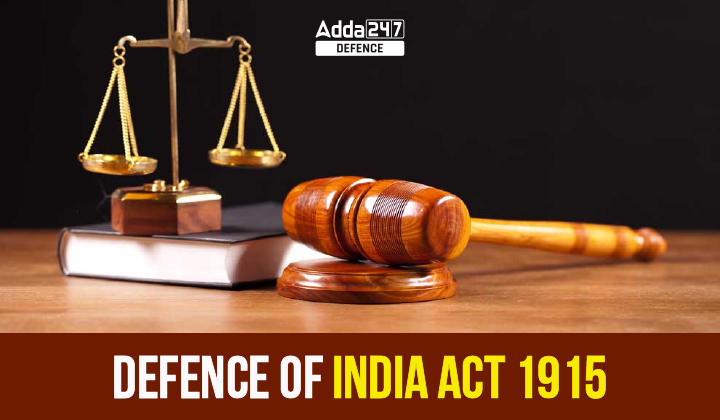Defence of India Act 1915
The Defence of India Act, also known as the Defence of India Regulations Act, was a law passed in 1915 by the Governor-General of India. This legislation aimed to restrict and control the nationalist and revolutionary activities of the Indian Independence Movement during and after World War I. Its primary objective was to maintain order and suppress any actions that were perceived as a threat to the British colonial rule in India.
History of Defence Of India Act 1915
During the early 1900s, Punjab, Bengal, and Maharashtra became key centers of India’s revolutionary movement, driven by factors such as the Partition of Bengal in 1905 and the colonization bill in Punjab, which led to widespread discontent.
During World War I, approximately 1.3 million Indian soldiers and laborers served in various regions including Europe, Africa, and the Middle East. The onset of the war also sparked a fresh wave of popular unrest in India due to factors such as rising grain prices, dissatisfaction with British immigration policies, and rumors of British defeats on multiple fronts.
Despite India being geographically distant from the European conflict, British authorities were apprehensive about the potential alliance between the Central Powers and Afghanistan. The prospect of Afghanistan invading the North-West Frontier and internal unrest fueled by revolutionary networks became significant concerns for the British. They recognized the need to enact a new legislation to stabilize the domestic front and maintain control over India during this critical period.
Defence Of India Act 1915 Overview
In response to the patriotic and progressive demonstrations that emerged in India following the outbreak of World War One, the Governor-General of India introduced the Defence of India Act in 1915. The purpose of this act was to curtail and suppress these demonstrations.
| Defence of India Act in 1915 | |
| Name of the Act | Defence Of India Act 1915 |
| Primary Objective | The Defence of India Act of 1915 was enacted to ensure the protection of public safety and defense in British India by implementing extraordinary measures and expediting the handling of specific offenses. |
| Territorial Extent | The whole of British India |
| Enacted by | The Governor-General in Council |
| Enacted & Commenced | 19 March 1915 |
| Status | Succeeded by the Defence of India Act, 1939 |
The Implementation of the Defence of India Act 1915
The implementation of the Defence of India Act 1915 allowed the local government to appoint commissioners, who did not necessarily have to be high-court judges, to preside over trials under the provisions of the law. As long as at least two of these commissioners had served as Sessions judges or extra Sessions judges for a minimum of three years, they were eligible for appointment as High Court Judges.
This Defence of India 1915 Act superseded the Indian evidence statute of 1872 and introduced provisions allowing commissioners to accept statements recorded by a magistrate as evidence, without the need for inspection or cross-examination. Moreover, commissioners were authorized to accept recorded testimony in cases where witnesses were unavailable or deceased. These measures were intended to prevent violence and assassination by revolutionaries and supporters of the circumstances.
Notably, the Act did not provide for jury trials, and the decisions made by the appointed commissioners under the Defence of India Act 1915 were exempt from appeal or judicial review. While the primary aim of the law was to maintain peace and restrict the activities of revolutionaries, it was applied in various ways, including prosecuting those involved in religious violence and limiting the influence of moderate political figures.
Unlike the Defence of the Realm Act, which targeted individuals of hostile origin or associations such as enemy citizens or collaborators, the Defence of India Act 1915 could be applied to anyone who was a subject of the King.
The Impact of the Defence of India Act 1915
The Defence of India Act 1915 received unanimous support from Indian non-officiating members of the Governor General’s council and moderate leaders within the Indian Political Movement. The act was seen as necessary for the war effort, which enjoyed popularity in India.
The implementation of the act resulted in a significant decrease in violence in India. However, there was growing discontent among the Indian population due to the widespread use of the act by both ordinary citizens and even leaders.
Notably, the Lahore and Benares conspiracy trials and other courts in Bengal saw 46 revolutionaries executed, while 64 received life sentences, effectively bringing an end to the revolutionary struggle. The power of preventive detention was extensively employed in Bengal.
The Bengal Police successfully suppressed the Dhaka Anushilan Samiti in March 1916 through a series of arrests in Calcutta. By August 1916, Bengal was fully subjected to the regulations outlined in Regulation III and the Defence of India Act 1915.
By 1917, only ten incidents of revolutionary violence were reported in Bengal. Throughout the war, over 800 Bengali prisoners of war were detained under the provisions of the act.




 CDS Previous Year Question Papers, Downl...
CDS Previous Year Question Papers, Downl...
 AOC Result 2025 Out, Download Link Activ...
AOC Result 2025 Out, Download Link Activ...
 NDA 1 Admit Card 2025 Out, Download NDA ...
NDA 1 Admit Card 2025 Out, Download NDA ...












